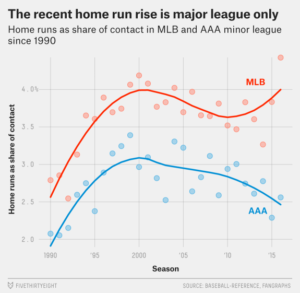
by Steve Haner
Maybe if a claim is repeated more than once, it won’t sound so absurd? Perhaps that is why the Richmond Times-Dispatch felt it necessary to print two stories today about the recent ludicrous claim that “climate change” is making it easier to hit a home run.
“Since 2010, more than 500 dingers can be linked to warmer than average conditions because of climate change, according to a new study,” is the summary in a photo cutline illustrating one of the stories, a Washington Post reprint on page C-2. The paper’s full-time climate alarmism correspondent Sean Sublette also discusses the “study” in his column on his daily weather and climate crisis page.
Perhaps neither had seen that the Post’s original story quickly drew a response so strong as to constitute disproof, from another climate scientist, this one not a member of the climate crisis priesthood. The Unbeliever dared to compare the Major League Baseball home run statistics at the heart of the “study” with similar home run statistics from AAA baseball, the NCAA’s Division 1 baseball teams, and even the Japanese professional leagues.
The home run patterns there are different. It seems climate change is only happening in MLB stadiums. What a relief!
The University of Colorado’s Roger Pielke, Jr. packaged his response on Twitter, and it was then shared by The Wall Street Journal. Very much worth a read. You won’t find any of the rebuttal data in that failed rag of a Richmond newspaper.
Believe it or not, those two silly science stories were not the worst example of climate alarmist reporting in today’s RTD. Right on the front page, on another follow up story about the Hopewell chemical plant’s regulatory problems, was the following subhead, at least in the print edition:
“City vows to address climate concerns following report.”
This was the first time an effort has been made to link the problem of chemical leaks to “climate change.” The chemical leaks don’t involve greenhouse gases, and don’t involve amounts that would have any impact whatsoever on GHG levels. If they are happening, they are real pollution by manufactured chemicals. The newspaper’s agenda is clear, an effort to link real pollution from dangerous chemicals that could end life to the imagined pollution from natural gases that sustain life.
This is constant with this newspaper. Other recent examples are very easy to find. To the recent archives:
Sublette’s climate crisis page on Friday, April 7 featured a wire story about offshore oil drilling with advocates complaining about the high risk of pollution from well remains. But this was on the climate crisis page, so the real point is that oil drilling must stop because, well…climate change!
The next day, Saturday, April 8, the climate crisis page headline was “Methane big part of ‘alarming’ rise in planet-warming gasses,” illustrated with a photo not just of a landfill, but a burning landfill. (Hello, if you burn methane what enters the atmosphere is no longer methane; it breaks down. But real science gets in the way so never mind that.)
Sunday, April 9, we move from the climate page to “Week in Virginia” for this one paragraph story:
Norfolk is the East Coast city most threatened by sea level rise, according to a study by the Virginia Institute of Marine Science at William and Mary. The Sea Level Report Card shows the city has a rise rate of .212 inches per year….
Since it was just one paragraph, perhaps we forgive the editor for failing to remember that Hampton Roads is sinking, and the subsidence has a far greater impact on relative sea level than any rise in the tide. VIMS is reporting relative sea level rise of 5.4 millimeters per year, which is higher than the actual measurements from the National Oceanic and Atmospheric Administration (NOAA) of 4.75 mm per year.
And the NOAA figures do show other East Coast gauges (including in Virginia) with higher relative sea level rises, but perhaps those are not “cities.” The goal was a scary headline, after all.
There was a climate crisis page in the Easter Sunday edition, of course, but its story was a good news story about how a Gulf Coast shipbuilder is building a ship to service offshore wind facilities. They did have to nod at the altar at least once in the story, though: “Globally, countries are building out wind power and solar in a shift away from the coal, oil and methane gas burning that cause climate change.”
Finally there was yesterday, Monday, April 10, and a climate crisis page story about the expanding use of coal in countries not seeking to drive their populations into energy and economic poverty. Give the editors credit for printing the kind of news that the climate priesthood wants to suppress, because 30 years of screaming against coal has not stopped its expansion outside of the U.S., and even Europe ran back to it once Russia cut off its gas.
So go to the baseball game and enjoy all the extra home runs. The priests tell us we’ll be flooded out, broiling in Sahara-like heat and forced to eat grasshoppers soon. A ball game sounds like a nice distraction.

Leave a Reply
You must be logged in to post a comment.